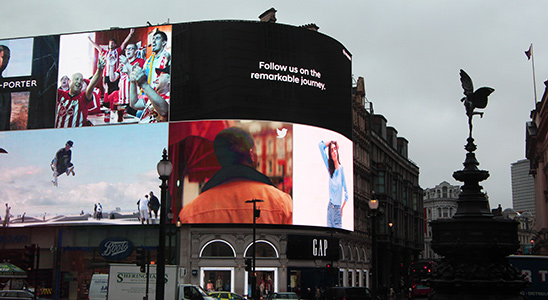Small businesses today often dip their toes into both physical retail stores and digital storefronts — but businesses could be missing out on one of the best mergers between the two mediums. Digital signage brings digital advertising into the physical storefront to boost sales, upsell, and keep customers coming back. In fact, a recent study by Nielsen found that 80 percent of grocery stores that switched to digital signage saw sales jump by as much as a third.
So how can small businesses use digital signage, and what are the benefits of making such an adjustment? Here’s what small businesses need to know about digital signage before making the investment.
Unlike printed signs, digital signs have time on their side.
Digital signs don’t have to be still images — integrating video into digital signage is eye-catching and opens up several different possibilities. First, using video on a digital sign can help tell a brand’s story better than with a single still image or even slideshow of images. A story about your business spans time — and since digital signage can also span time, it makes a great medium for sharing your business’ story.
Consider the possibilities of sharing video in store — you could demonstrate a product’s features, show a product from all angles, or offer tutorials on how to use an item.
Digital signs can be interactive.
Digital signage isn’t limited to photos and video. Touchscreen digital signs encourages customer interactions. A product finder questionnaire can use customer feedback to help them find the right product, for example. Digital signs can also be used to help drive social media marketing or to display your most recent posts.
Digital signs can house the same features as online platforms.
Online, customers can see a product outside the box from every angle with 3D models, read customer reviews, find similar products, and more. A digital sign allows business owners to bring those same features into a physical store. Besides adding helpful information, that means digital signs don’t always need extra effort to come up with new content, when the content you are already using online may already work.
Digital signs are more likely to capture customer’s attention.
The human eye is automatically drawn to movement — which means digital signage tends to draw more attention than traditional signage. The movement on screen is more eye catching, and stands out among the more common printed sign. That can be a big perk for small businesses working in crowded places, such as in malls and busy shopping centres. Businesses with a storefront window can even use digital signs to grab the attention of those walking by.
Digital and retail storefronts don’t need to remain segregated — by bringing digital signage into physical locations, small businesses can capture customer’s attention, increase sales, share details about products and more.
